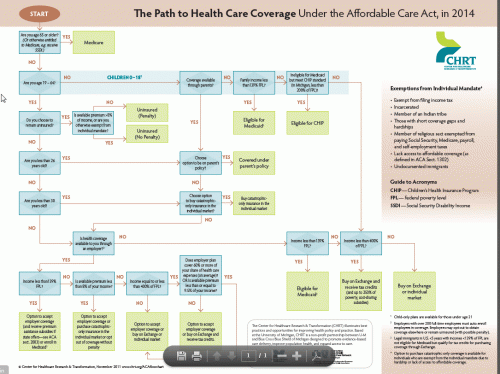It has been fascinating to show people the CHRT‘s chart of how people would get health insurance under the ACA, and to listen to what they see (complicated; simple; clear; confusing; Medicare much simpler; no it is more complicated; it is simple in one sense, complicated in another, etc.).
Austin’s take was that the chart is misleading because it says “if age 65 plus or otherwise eligible for Medicare, then you have Medicare” while it then provides a flow chart for everyone else. Essentially, the box “to Medicare” could have an asterisk that says “flip to the back for the Medicare flow chart.” Recently, I helped an age-eligible Medicare beneficiary decide what to do inside the “Medicare” box of the chart.
- She had been covered by a combination Medicare supplement/prescription drug plan for the past 6 years, provided by the company from which her spouse retired 19 years ago; this company decided to drop all employee health insurance benefits beginning Jan. 1, 2012.
- That means that she can sign up for a Medigap plan and a Part D prescription plan with no penalty for late sign up so long as she does so during the Medicare open enrollment period (Oct 15-Dec 7, 2011).
- She could also sign up for one of 19 Medicare Advantage plans available in her zip code (private option that combines Parts A, B, D and Medigap).
- After talking with her I concluded several things: physician choice was very important to her, to an extent that I consider to be the extreme, so this tilted me away from Medicare Advantage plans, some of which had either/or choices in terms of one health system on another where she lives and she currently sees docs in both systems.
- Picking the Medigap plan to cover what Part A and Part B do not cover was fairly straightforward, and plan F was the one for her given historical use patterns. There was one that provided the most physician choice available to her. Interestingly, it also had the lowest premiums so it was an easy call. This turns the more choice/higher premium assumption on its head. I think this is due to the fact that it is by far the dominant insurance carrier in this state. update: In theory all Medigap plans cover all docs that accept Medicare, but there was a therapeutic example in this person’s medical history related to the application of a non-pharmaceutical therapy in which a plan stipulated they would supply the needed factor, and some physicians will not do it this way.
- Prescription drug plans were trickier. This person takes 14 prescriptions, several of which are very expensive; she refuses to do mail order; she insists on using one pharmacy that is very small. These preferences (esp mail order) trimmed the list quickly and left 4 options.
- I used an online tool and entered the pharmaceuticals taken and got a clear out of pocket and premium estimate. I also checked with her pharmacy to ask a few questions.
- I picked the best one and it was offered by a company she had told me at the beginning of the process that she would “never do business with them because they were in business with the government.” I showed here that the second best plan would cost her about $1,100 more in out of pocket costs in a year and she changed her mind.
- Bottom line: it was easy finding a Medigap plan and coverage is about the same as what she had. The prescription plan she had before was tons better (for her) than any Part D plan available; I see why the company wants out of providing that to spouses of retirees (also, the initial company has now been sold 4 times and the helpful person on the telephone said it was easier (and of course cheaper) to get out of the retiree health insurance business than to try and unify all the plans).
- I spent 5-6 hours investigating this and around 2 hours over three conversations to convince the Medicare beneficiary that my suggestions represented the best route.
This is what Austin had in mind when he said Medicare is complicated.
DT


